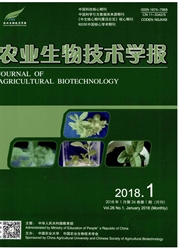

 中文摘要:
中文摘要:
利用PCR技术扩增了鹅细小病毒(Goose parvovirus,GPV)HG5/82株vp1基因5’端长662bp的基因片段,将其克隆到pMD18-T Simple载体后.转化入大肠杆菌(Escherichia coli)DH5d细胞。筛选阳性质粒,并通过BamHI和HindⅢ将外源基因定向克隆到原核表达载体pPROEXTMHTb,所得的阳性重组质粒经序列测定,证明外源片段正确插入到pPROEX^TM-HTb的预期位置。将转入外源基因的工程菌经0.6mmol/LIPTG诱导,SDS-PAGE电泳表明,外源基因表达,融合蛋白分子量约为32kD。通过薄层扫描分析显示,融合蛋白表达量占工程菌菌体总蛋白的22.8%。经诱导后的工程菌用6mol/L盐酸胍裂解,再经超声处理后离心,用镍离子亲和树脂对裂解产物的上清进行纯化。纯化所得的融合蛋白免疫白兔,制备了兔抗鹅细小病毒结构蛋白的抗血清。Western blot结果表明,抗血清与表达的融合蛋白及亲本病毒的VPI和VP2都具有反应性。
 英文摘要:
英文摘要:
A 662 bp fragment at 5'- end ofvpl gene of Goose parvovirus (GPV) isolate HG5/82 was amplified by PCR. The PCR product was cloned into pMDI 8-T Simple vector and the recombinant plasmid was transformed into Escherichia coli DH5α. After digesting with BamH Ⅰ and Hind Ⅲ, the inserted fragment was subcloned into prokaryotic expression vector pPROEXTMHTb and the recombinant plasmid was verified by DNA sequencing and transformed into E.coli DH5~x. SDS-PAGE results indicated that engineering bacteria could express a 32 kD product after inducing with 0.6 mmol/L IPTG. Densitometric scanning showed the expressed fusion protein could account as much as 22.8% of total bacterial protein of DH5α. The induced engineering bacteria were lysed by 6 mol/L guanidine hydrochloric acid and ultrasound, then the fusion protein was purified with ProBondTM resin from the suspension centrifuged. Antiserum against the fusion protein was obtained by immunizing rabbits. Western blotting analysis showed that the antiserum could specifically recognize the fusion protein as well as VPI and VP2 of GPV HG5/82 strain.
 同期刊论文项目
同期刊论文项目
 同项目期刊论文
同项目期刊论文
 期刊信息
期刊信息
